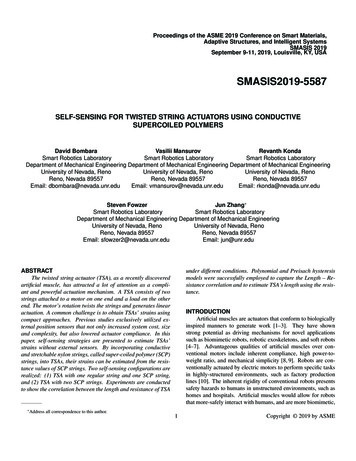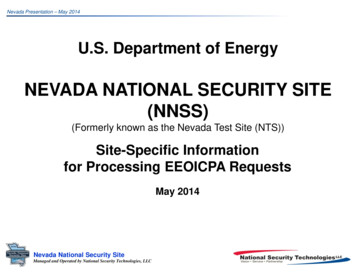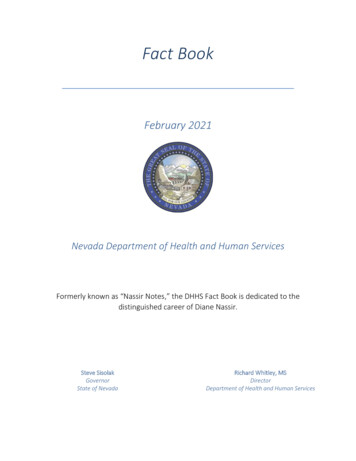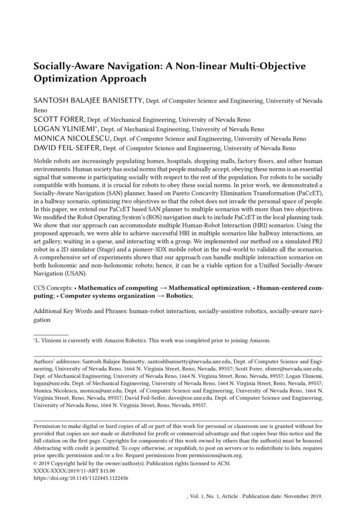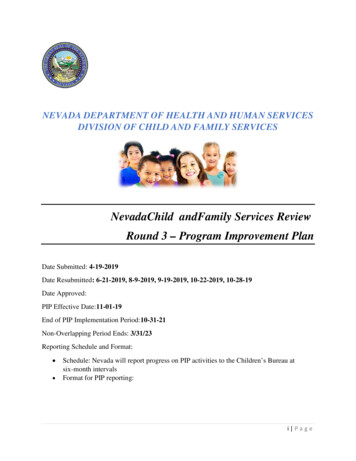
Transcription
NEVADA DEPARTMENT OF HEALTH AND HUMAN SERVICESDIVISION OF CHILD AND FAMILY SERVICESNevada Child and Family Services ReviewRound 3 – Program Improvement PlanDate Submitted: 4-19-2019Date Resubmitted: 6-21-2019, 8-9-2019, 9-19-2019, 10-22-2019, 10-28-19Date Approved:PIP Effective Date:11-01-19End of PIP Implementation Period:10-31-21Non-Overlapping Period Ends: 3/31/23Reporting Schedule and Format: Schedule: Nevada will report progress on PIP activities to the Children’s Bureau atsix-month intervalsFormat for PIP reporting:i Page
ContentsEXECUTIVE SUMMARY . 1INTRODUCTION. 2Identified Cross Cutting Performance Themes. 3Process for Performance Improvement Plan Development . 4Initiatives . 5Nevada SAFE Model Initiative . 5Quality Parenting Initiative (QPI). 6Community Improvement Councils (CICs) Initiative . 6Part One: Goals, Strategies, and Key Activities . 7Process for Determining Overarching Goals and Strategies of Goal 1 . 7Goal 1: Strengthen Safety for children in Nevada through improved practice regarding responsetimes, persistent efforts, safety planning, and initial and ongoing safety assessment. (Safety Outcome1 and Safety Outcome 2). 12Process for Determining Overarching Goals and Strategies of Goal 2 . 16Goal 2: Promote effective communication and contact with families (Permanency Outcome 2, WellBeing Outcome 1, Well-Being 2, Well-Being 3, Staff and Provider Training) . 18Process for Determining Overarching Goals and Strategies of Goal 3 . 24Goal 3: Nevada children have legal permanency and stability in their home lives and their continuityof family relationships and connections are preserved. (Permanency Outcome 1, and SystemicFactors: Case Review System), Foster Parent Recruitment and Retention.) . 31Process for Determining Overarching Goals and Strategies of Goal 4 . 37Goal 4: Improve Statewide Child Welfare Outcomes by developing and strengthening the StatewideQuality Assurance System to ensure the system can identify and respond to the strengths and needsof the child welfare system in an efficient and effective manner. (Systemic Factors: StatewideInformation System, Quality Assurance System, sand Service Array). 41PART Two: CFSR PIP Measurement Plan. 48Statewide Measurement . 48Conflict of Interest: . 49Minimum Qualification for a Case Reviewer: . 49Minimum Qualification for 1ST and 2nd QA Level: . 50Preferred Qualifications for all positions: . 50In-Home Cases: . 54Out-of-Home Cases:. 54Cases are eliminated for the following reasons: . 54ii P a g e
Optional Interviews . 55Case-Specific Interviews . 56APPENDIX A: Glossary of Acronyms . 60iii P a g e
EXECUTIVE SUMMARYThe 1994 Amendments to the Social Security Act authorize the U.S. Department of Health and HumanServices to review state child and family service programs to ensure conformity with the requirements intitles IV-B and IV-E of the Social Security Act. The Children’s Bureau (CB), part of the Department ofHealth and Human Services, administers the review system, known as the Child and Family ServicesReviews (CFSR).In 2000, the Children’s Bureau published a final rule in the Federal Register to establish a process formonitoring state child welfare programs. Under the rule, states are assessed for substantial conformity withfederal requirements for child welfare services.All 50 states, the District of Columba, and Puerto Rico completed their first review in 2004 and their secondreview by 2010. Nevada completed round one in 2004 and round two in 2009. The third round of reviewswere conducted from 2015 to 2018 for all 50 states. Nevada competed its third round in September of 2018.The Child and Family Services Reviews enable the children’s Bureau to: (1) ensure conformity with federalchild welfare requirement; (2) determine what is happening to children and families as they are engaged inchild welfare services; and (3) assist states in enhancing their capacity to help children and families achievepositive outcomes.The reviews are structured to help states identify strengths and areas needing improvement within theiragencies and programs. Ultimately, the goal of the reviews is to help states improve child welfare servicesand achieve the following seven outcomes for families and children who receive services:Safety Children are, first and foremost, protected from abuse and neglect.Children are safely maintained in their homes whenever possible and appropriatePermanency Children have permanency and stability in their living situationsThe continuity of family relationships and connections is preserved for familiesFamily and child Well-Being Families have enhanced capacity to provide for their children’s needs.Children receive appropriate services to meet their educational needs.Children receive adequate services to meet their physical and mental health needs.1 Page
The reviews also measure state performance on seven system factors, including the effectiveness of (1) thestatewide child welfare information system; (2) the case review system; (3) the quality assurance system;(4) staff and provider training; (5) the service array and resource development; (6) the agency’sresponsiveness to the community; and (7) foster and adoptive parent licensing, recruitment, and retention.The 2018 CFSR found Nevada to be out of substantial conformity with all seven outcomes and six of theseven systemic factors. Nevada is charged with developing a Program Improvement Plan (PIP) thataddresses all areas rated as not in substantial conformity.After the review ends, the Children’s Bureau is required to issue a final report. The report is accompaniedby a cover letter that includes an estimate of the amount of any applicable penalty. Nevada’s final reportwas received on 01/22/2019 with an estimated penalty of 1,068,285.00. Nevada must submit the PIP tothe Children’s Bureau Regional Office for approval within 90 calendar days from the date on which thestate receives written notification that Nevada is not operating in substantial conformity with any one of theseven outcomes or seven systemic factors. If the Children’s Bureau does not approve the state’s initial PIPsubmission, the Children’s Bureau will provide additional information to help the state revise it, and thestate has 30 calendar days of receiving written notice to amend the plan.The PIP must be designed so that its implementation is completed no later than two years from the date onwhich it is approved by the children’s Bureau. If at the end of the PIP, the state has not demonstrated therequired amount of improvement on the measurement goals, the state may submit additional data throughthe end of the 12-month non-overlapping period following the end of the implementation period.INTRODUCTIONNevada uses a state-administered and county operated structure for the management of child welfareservices, except in the rural counties of the state, where the Nevada Division of Child and Family Services(DCFS) operates child welfare services. The DCFS, under the umbrella of the Nevada Department ofHealth and Human Services (DHHS), provides oversight to child welfare and direct child welfare services.DCFS is responsible for Children’ Mental Health in Clark and Washoe Counties (the two largest populatedcounties) Juvenile Justice Services, and Child Welfare Services. As such, the implementation andadministration of the Child and Family Service Plan (CFSP) is the responsibility of DCFS. This includes:Title IV-E, Title IV-B, Subpart I (Child Welfare Services) and Subpart II (Promoting Safe and StableFamilies), Child Abuse and Treatment Act (CAPTA), and the Chafee Program.Nevada does not have a unified court system, and all dependency matters are handled by the State DistrictCourts. These are courts of general jurisdiction where major civil, criminal, family, and juvenile cases aredecided. Appeals of District Court cases go to the Supreme Court. The 11 Judicial Districts (JD), four ofwhich are multi-county districts, are depicted in Figure 1. The District Court boundaries align with the childwelfare agency field management structure in only two urban districts, Clark (8th JD) and Washoe (2nd JD)Counties.2 Page
Figure 1 Nevada Judicial DistrictsIdentified Cross Cutting Performance ThemesDuring 2018 Nevada utilized a state-conducted review path for Round 3 of the CFSR. States must meetqualifying criteria to be approved by the Children’ Bureau (CB) to be allowed to conduct their own casereviews. Nevada collaborated and developed Memorandums of Agreement (MOUs) with Clark CountyDepartment of Family Services (CCDFS) and the Washoe County Human Services Agency (WCHSA) touse staff and resources to conduct the CFSR.The reviews identified Nevada to be out of substantial conformity with all seven outcomes and six of theseven systemic factors. Nevada is charged with developing a Program Improvement Plan (PIP) thataddresses all areas rated as not in substantial conformity.The following practice themes were identified as areas of concern during the reviews: Conducting Quality Safety and Risk AssessmentsoooooConducting comprehensive risk and safety assessmentsFocusing on in-home casesDeveloping appropriate, realistic, and specific safety plansFormalizing maltreatment reports on open casesProviding safety services3 Page
Engaging Familiesooooo Achieving Timely Permanencyooooo Effective family engagementConducting high quality caseworker visits and case planningFocusing on in-home casesEffective relative engagementConducting accurate needs assessment and case planningEffective use of concurrent planningEffective and timely planning for adoption and provision of adoption servicesPlanning for, pursuing, and supporting timely reunificationStrengthening court case review processes and communication/partnership with courtsFiling timely TPR petitions per ASFAContinuous Quality ImprovementoooooDeveloping a comprehensive CQI systemBuilding capacityStrengthening data collection, tracking, sharing, and analysisStrengthening the link between data analysis and decision-makingTracking interventions and outcomesProcess for Performance Improvement Plan DevelopmentTo develop the PIP, DCFS received technical assistance from the Capacity Building Center for States(CBSC) and the Capacity Building Center for Courts (CBCC). Nevada utilized a teaming approach withinternal and external stakeholders in the process of problem exploration. DCFS engaged several key internaland external stakeholders in developing teams that represented each of the four cross-cutting practicethemes, i.e. judges and youth. In January 2019, the CBCS and the CBCC provided a statewide training viaAdobe Connect on Root Cause Analysis to Stakeholders. In February 2019, over 100 stakeholders convenedto review the results of the CFSR with the Children’s Bureau in Carson City, Nevada. These stakeholdersrepresented a diverse internal and external group across the state. Teams were assembled around the fourcross cutting performance themes of: Team (1) Conducting Quality Safety Assessments, Team (2)Engaging Families, Team (3) Achieving Timely Permanency and Team (4) Continuous QualityImprovement. During this convening, there were team break outs to start the process of problem explorationwith each team and to set the course for future meetings. The teams were comprised of county staff, statestaff, judges, youth, and other entities that represent child welfare across the state.Additionally, internally and in collaboration with CCDFS, WCHSA and the DCFS-Rural, a CORE SteeringTeam was organized to guide each of the four teams throughout the process. A member of the CORE teamalso chaired or co-chaired the teams. The CORE Team and the practice themed teams developed a charterand communication plan which provided bi-directional communication with the teams, and the ExecutiveLeadership Committee. An Advisory Committee was assembled of internal and external stakeholders i.e.parent advocates, birth parents, CASA, aged out Foster Youth, Providers, CJA task force and foster parents.This committee will also serve as advisory to the Child and Family Services Plan (CFSP).4 Page
The general approach taken by the four teams involved utilizing a period of problem exploration followedby data identification, analysis, developing research questions, analyzing root causes of performance anddeveloping a theory of change for each root cause. Additionally, a data team was convened to assist withproviding data for analysis. All teams met weekly or more to explore the problem in as much depth aspossible considering the time constraints and created a data plan. During problem exploration and upondevelopment of the data plan it was discovered there was not enough quantitative data to gain enoughinsight into some of the identified problem areas. The CBSC assisted the teams in conducting focus groupswith Foster Parents, Youth, Supervisors, Caseworkers and Parents as a source of qualitative data to fill inthe gaps. Teams then identified possible contributing factors and root causes of the identified problems.This process provided for the development of the goals, strategies and action steps for Nevada’s PIP.InitiativesNevada SAFE Model InitiativeNevada has been involved in Nevada’s SAFE Model Initiative for more than a decade and has been workingtowards improving the assessment of safety since Round 1 of the CFSR PIP in 2006. Nevada has historicallyused ACTION for Child Protection through contractual funds or received technical assistance from theNational Resource Center for Child Protective Services (NRCCPS) when they were funded by theChildren’s Bureau.The DCFS-Rural and WCHSA met and moved forward with implementation of the enhanced safety modelbeginning in 2010-2011. The SAFE Model was fully implemented in 2016 in WCHSA, and the DCFSRural has fully implemented six of eight offices but continues working towards full implementation in twoof the DCFS-Rural Offices. CCDFS currently has a contract with ACTION that will end in June of 2020.This contract is for continued support in fidelity enhancement, supervisory competence for InitialAssessment (IA), Nevada Initial Assessment (NIA), Parental Capacity Family Assessment (PCFA),Parental Capacity Parent Assessment (PCPA), court collaboration, engagement and internal expertise forsustainability.Child Safety is the operating concept applied throughout the SAFE Model. All assessments in the SAFEModel are designed to evaluate the presence of danger to children and consider caregiver protectivecapacities. The initial assessment worker recognizes the importance of knowing and using essential safetyconcepts and practices that are necessary to perform effective practice and decision making. The essentialsafety intervention concepts applied during initial assessment are: Safe and unsafePresent dangerImpending dangerDanger thresholdAllegations of child abuse and neglectIn March 2019 during statewide focus groups with caseworkers and supervisors it was expressed that theSAFE Model is designed for caseloads of 15-18 children but that the current caseload size is much larger.Higher Caseloads place a strain on Caseworkers and Supervisors ability to adhere to the fidelity of themodel, and additionally it affects the quality of safety assessments.5 Page
Quality Parenting Initiative (QPI)Nevada has been involved in the Quality Parenting Initiative (QPI) since 2013. The Quality ParentingInitiative (QPI) is an innovative approach to strengthening foster care, including kinship care, and usingbranding and marketing principles. It is a process designed to help a site develop new strategies andpractices, rather than imposing upon it a predetermined set of “best practices.” The core premise is that theprimary goal of the child welfare system is to ensure that children have effective, loving parenting. The bestway to achieve this goal is to enable the child’s own parents to care for him or her. If that isn’t possible, thesystem must ensure that the foster or relative family caring for the child provide the living, committed,skilled care that the child needs, while working effectively with the system to reach the child’s long-termgoals.QPI recognizes that the traditional foster care “brand” has a negative connotation and that this detersfamilies from participating. QPI is an effort to rebrand foster care, not simply by changing a logo or anadvertisement, but by changing the core elements underlying the brand. When these changes areaccomplished, QPI sites are better able to develop communication materials and to design recruitmenttraining and retention systems for foster parents. QPI has been a way to engage foster parents and fosterparent surveys have indicated that QPI has been helpful in Nevada.Community Improvement Councils (CICs) InitiativeIn response to the PIP from the 2nd round CFSR (2010), the courts were asked to develop a workgroup toaddress reducing barriers to adoption and TPR. Rather than create one large workgroup, CIP asked eachjudicial district to create a platform/forum for ongoing identification of strengths and opportunities as theypertain to child welfare outcomes. As a result, each judicial district created a Community ImprovementCouncil (CIC) of local stakeholders to identify barriers to timely permanency, adoption, and TPR; anddevelop and implement solutions to these barriers in its locale. These CICs continue to meet and discussissues relevant to children welfare and court dependency.CIP produces quarterly and annual data packets containing court timeliness, child welfare, and trendmetrics. The timeliness data metrics distributed to the CICs quarterly allow for comparison over time aswell as comparison among judicial districts. Because each judicial district is unique, the specific localactivities and interventions for that district have been built on a foundation of empirical data and consensusamong the key stakeholders and constituency of that district. These data are also used to guide CIP’sdiscussions with the judiciary and their CICs during their regularly meetings so local stakeholders can workto improve timeliness and resolve systemic problems. With help from the National Council of Juvenile andFamily Court Judges, CIP conducts the CIC Summits, targeted annual convenings of CIC stakeholder teamsfrom each of the judicial districts, to reinforce their work and advance new initiatives.6 Page
Part One: Goals, Strategies, and Key ActivitiesProcess for Determining Overarching Goals and Strategies of Goal 1Goal 1: Strengthen Safety for children in Nevada through improved practice regardingresponse times, persistent efforts, safety planning, and initial and ongoing safety assessments.Team (1) Conducting Quality Safety Assessments identified the goal and used the following processdescribed below in determining strategies.The Family Programs Office (FPO) with the Division of Child and Family Services (DCFS) along withstakeholders from the Child Welfare Agencies in Nevada, to include front end case workers, supervisors,managers/coordinators and leadership, formed a team to examine both quantitative and qualitative data,which led to decisions about strategies and key activities for this Program Improvement Plan (PIP). Theymet to understand the root cause of the lack of timely, thorough and accurate safety assessments, efforts toimplement and monitor sufficient safety plans, and the ability to keep children from entering or re-enteringfoster care. As applicable, specific data points were examined within each strategy outlined for this cross cutting theme. CFSR Round Three Final Report CFSR Data specific to Items 1, 2, and 3 Retention data of workers and supervisors, including annual turnover data and average length oftime in position or agency. Time to completion of initial safety assessment (both Present Danger and Nevada InitialAssessment) Time to completion of Nevada Initial Assessment (NIA) for cases that have children found to beunsafe and opened for ongoing services. Focus Groups with front line staff, supervisors, foster parents, birth parents and youth Data reporting availability regarding cases where priority response times are not being met with“face to face” contact with the child. Case data regarding Safety Plan Determination (SPD), Safety Plan (SP) and ongoing SafetyAssessments (SA) when cases are referred for service (opened for ongoing services) Annual Progress and Services Review (APSR) report statewide staffing and turnover data Statewide availability of informal and formal safety service providersAn analysis of Item 1 CFSR data (80 cases total) indicated that the state of Nevada was meeting the federalexpectation 58.3% of the time (21/36 cases); however, 41% of the time, Nevada is not meeting theperformance expectations of Item 1, Timeliness of Initiating Investigations of Reports of ChildMaltreatment. Of applicable cases reviewed for Item 1 statewide during the CFSR, 41% (15 cases) wererated as Area Needing Improvement (ANI), while the federal substantial conformity standard is 95% of7 Page
reviewed cases rated as a Strength. Themes identified from this analysis show issues with persistent effortsbeing made, with three being rated ANI for this reason, and in 12 cases children were not seen timely,meaning either all the children were not seen timely or the initial report was not initiated timely. Thisimpacted In-Home, Foster Care and Differential Response (DR) cases. Out of the 15 cases that wereidentified as areas needing improvement, 12 of these cases were in-home cases and/or in-home DR cases.To dig deeper, the team evaluated its ability to understand, monitor and track work performance forinitiating reports of child maltreatment. The team found there was a lack of clarity and understanding aboutresponse times and persistent efforts. Three policies were identified that impacted this lack ofunderstanding, Intake 506, NIA 508 and NIA 509. The Nevada Revised Statute (NRS) and NevadaAdministrative Code (NAC) also lead to different interpretations and misunderstanding about therequirements. Specifically, the NIA Policies list different requirements for which children need to be seen,in one section it requires face to face contact with the identified child(ren) within response time and in adifferent section it requires private interviews with all children residing in the home within responsetime. Nevada Revised Statute requires an assessment of all children in the household but does not specifya timeframe besides immediately when certain criteria are alleged. Nevada Administrative Code requiresdaily attempts at face to face contact if the case is initiated by telephone or case record review but is notclear as to what to do when attempted face to face contact fails initially. Given current policy, NRS andNAC requirements, there are clarifications that can be made that will better direct the workforce that willbe made in Strategy 1. Key activity 1.1.1 will address the lack of clarity and understanding by deliveringtraining and subsequent follow up. Additionally, key activity 1.1.2 will clarify two policies that directlyimpact this root cause.UNITY, the statewide data system, was found to have limited ability to record and report out on timeliness.The report detail window captures the response type and allows for one response time and date per report.The report detail window does not allow for a worker to specifically show that they met with all the childrenin the report, at which times, through which method (face to face, by phone, etc.); therefore, the agenciescannot accurately track and monitor performance. A report was pulled from UNITY in an attempt to showresponse times, but it could only show cases where “face to face with child” was not chosen in the reportdetail window and then it was difficult to aggregate any understanding about whether all children were seentimely from the report. Another reporting issue identified with UNITY was the system’s inability to reporton whether daily face-to-face contact attempts are made on cases where the child was not seen withinpriority response times. Key Activity 1.1.3 will address the ability to accurately track response timelinessand persistent efforts.One other contributing factor for response times being deficient is the lack of experienced staff with lessthan two years of experience working in child welfare across the state, which is discussed in more detailbelow.To understand this issue from a qualitative side, the team discussed it in the focus groups. It was believedhigh workload, turnover in staff, and a large percentage of the workforce having less than two years ofexperience also impacted the timeliness of investigations (being addressed in Goal 2, Strategy 2). Therewas question as to whether supervisors and managers fully understood the requirements. Focus groupswere asked about their understanding of response time, persistent efforts and barriers to achieving timelyinvestigations.Caseworkers from across all three jurisdictions indicated these were the barriers bulleted below: Conflicting schedules and priorities: court, placements, new reports,High caseloads with many demands8 Page
Assigned more than one report in a day, varied type of reports requires more time; e.g. presentdanger or placement.Several children in different locationsCoordinating with police when required, may have to wait for hoursTime lapse between report time and assignment time (P2 some wait until next day to assign)Transient population and difficulty locating familiesSupervisors from across all three jurisdictions indicated these were the barriers bulleted below: Time starts when the call is receivedLaw enforcement and collateral contacts count as initiation but is not best practiceFace to face with the victim(s). State policy is face-to-face with every child(ren) regardless if theyare the victim within the priority response timeIf no one is at home, document and go back the next day or start calling to see if you can find themDepending on nature of report, will try to go again later in day or if needed, will have EmergencyResponse Team (ERT) try or swing shift, document all attempts or if it is a P1 have ERT or Swingshift initiate first contact. The rural regions do not have an ERT or swing shift unit to initiatecontact.Continued efforts to see children daily that are identified on the reportPriority is face-to-face contact, but other options available.Concerted Efforts – general practice is one attempt. Either school, home, if not there, waiting untillater or the next day unless staffed and high danger then need to try multiple times a day.Based on ongoing discussion within the team and the data exploration, Safety Outcome 1 was drilled downto one root cause: There is a lack of clarity around expectations for response time and persistent efforts, which led toone strategy with multiple key activities.To address this root cause, the team identified the following strategy: Strengthen safety by ensuring all alleged victims of maltreatment identified in the intake assessmentare seen by staff within defined timeframes and when unable to do so, appropriate persistent effortsare made.This strategy will clarify the expectations for response times for reports of maltreatment and persistentefforts. Additionally, workers will be able to accurately record response times and the Ag
EXECUTIVE SUMMARY. 1. INTRODUCTION. 2. . and initial and ongoing safety assessment. (Safety Outcome 1 and Safety Outcome 2). 12. Process for Determining Overarching Goals and Strategies of Goal 2 . Process for Performance Improvement Plan Development . To develop the PIP, DCFS received technical assistance from the Capacity Building Center .
